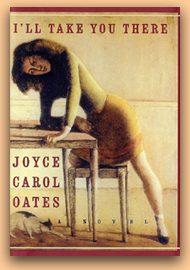
I'll Take You There
Joyce Carol Oates
Review by Mary Matus
In her latest book, I’ll Take You There, Joyce Carol Oates
takes readers back to Syracuse University in the early 1960’s. Although
the first section of the book may seem confusing, it is worth reading
as the last two sections become more interesting.
There are some interesting parts in the first section. The narrator, who is never named, recalls how her family never truly loved her, blaming her after her mother died only a year after the narrator was born. The first third of the book deals with the narrator’s obsession with joining the Kappa Pi Gamma. She explains this is due to her need to belong and her desire to have sisters. However, the sorority girls are portrayed as flighty elitists, while the narrator is poor and intellectual.
It is clear from the start that the narrator does not belong. Even if
the reader doesn’t realize it, the narrator keeps saying how she
doesn’t belong. In addition to her social problems, she also has
financial difficulties and cannot afford to remain in the sorority. She
is controlled by her obsession to belong, she doesn’t seem to have
a personality of her own and she keeps saying how pathetic she is. The
reader soon feels she is pathetic to the extent where it is hard to sympathize
with her.
She is much more defined in the second section where her obsession shifts to a black philosophy graduate student. Her love of philosophy and lack of materialism are much more clear. For that reason it becomes a little easier to know and understand who she is.
The last section is probably the best, as the narrator has to deal with
her past. It is possible at the end to truly sympathize with her.
Some readers may find other elements in the book more interesting than the narrator. For example, Oates’ portrayal of a college campus in the 1960’s may fascinate some readers. Women had to obey several rules of proper behavior, including curfews.
Although the narrator and her lover, Vernor, make a point of not paying attention to world events, it becomes difficult when they begin their interracial relationship. Through their relationship, Oates paints a picture of the status of African Americans during the early part of the civil rights movement. As the details of the sorority are interesting in the first section, the problems Vernor and the narrator face are actually more interesting than the characters.
Fans of Joyce Carol Oates will once again appreciate her writing style
and the way she describes an earlier time. However, I’ll Take
You There is not as strong a novel as other recent works such as Middle
Age and the masterpiece about Marilyn Monroe, Blonde.
Ecco; ISBN: 0060501170